
The bishop of Acre was a suffragan bishop of the archbishop of Tyre in the medieval Latin Kingdom of Jerusalem. Acre is present-day Akko, Israel.

The bishop of Acre was a suffragan bishop of the archbishop of Tyre in the medieval Latin Kingdom of Jerusalem. Acre is present-day Akko, Israel.
The introduction of Christianity to Ptolemais, as Acre was known in ancient times, dates back to Apostolic times. The Apostle Paul, returning from his trip to Macedonia, in Achaea and Asia, landed at Tyre, and from there traveled to Ptolemais, where he stayed some days with the local Christian community (acts 21.7).
The first bishop known is Clarus, who in 190 attended a Council meeting of some bishops of Phoenicia and Palestine to deal with the issue of the date of the Paschal feast. But we must go to the fourth century to find the next bishop, Aeneas, who took part at the First Council of Nicaea in 325 and at the Synod held in Antioch in 341. Nectabo was one of the fathers of the first Ecumenical Council of Constantinople in 381. Between the 4th and 5th centuries lived bishop Antiochus, opponent of John Chrysostom. Helladius participated in the first Council of Ephesus in 431. Paul took part in the Council held at Antioch of 445 to judge the work of Athanasius of Perrhe and at the Council of Chalcedon of 451. In 518 Bishop John signed a Synodal letter against Severus of Antioch and the Monophysite party. Finally, the last known bishop is George, who attended the second Council of Constantinople in 553.
With the conquest of the crusaders in the 12th century, the city, called St-Jean d'Acre, became part of the Kingdom of Jerusalem and was a diocese of the Latin Church, headquartered at the Cathedral of the Holy Cross. Against the eastern practice and ecclesiastical tradition, the Crusaders detached the diocese, along with the rest of southern Phoenicia, from the Patriarchate of Antioch, and made it a suffragan of Jerusalem.
After the fall of Jerusalem in 1187, the seat of the patriarch moved to Tyre and then to St-Jean d'Acre in 1191; the patriarch returned to Jerusalem in 1229, when the city was returned to the crusaders, then back to St-Jean d'Acre in 1244. St-Jean d'Acre had its own Bishop until 1263, when the patriarchs of Jerusalem administered it until the fall of the city into the hands of the Muslims in 1291. The most famous bishop of St-Jean d'Acre was the chronicler Jacques de Vitry.
Ptolemais in Phoenicia survives today as a titular see; until the mid-19th century it had the name Aconensis or Acconensis.
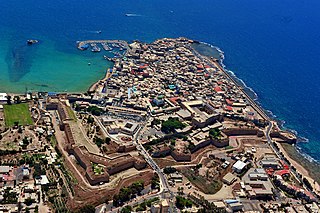
Acre, known locally as Akko and Akka, is a city in the coastal plain region of the Northern District of Israel.

Patriarchate is an ecclesiological term in Christianity, designating the office and jurisdiction of an ecclesiastical patriarch. According to Christian tradition three patriarchates were established by the apostles as apostolic sees in the 1st century: Rome, Antioch, and Alexandria. Constantinople was added in the 4th century and Jerusalem in the 5th century. Eventually, together, these five were recognised as the pentarchy by the Council of Chalcedon in 451.

Arqa is a Lebanese village near Miniara in Akkar Governorate, Lebanon, 22 km northeast of Tripoli, near the coast.
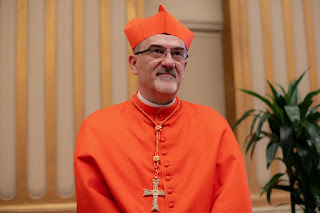
The Latin Patriarchate of Jerusalem is the Latin Catholic ecclesiastical patriarchate in Jerusalem, officially seated in the Church of the Holy Sepulchre. It was originally established in 1099, with the Kingdom of Jerusalem encompassing the territories in the Holy Land newly conquered by the First Crusade. From 1374 to 1847 it was a titular see, with the patriarchs of Jerusalem being based at the Basilica di San Lorenzo fuori le Mura in Rome. Pope Pius IX re-established a resident Latin patriarch in 1847.
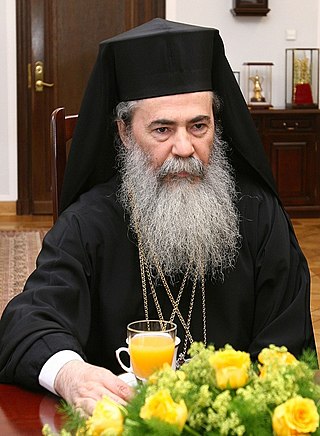
The Greek Orthodox patriarch of Jerusalem or Eastern Orthodox patriarch of Jerusalem, officially patriarch of Jerusalem, is the head bishop of the Greek Orthodox Patriarchate of Jerusalem, ranking fourth of nine patriarchs in the Eastern Orthodox Church. Since 2005, the Eastern Orthodox patriarch of Jerusalem has been Theophilos III. The patriarch is styled "Patriarch of the Holy City of Jerusalem and all Holy Land, Syria, beyond the Jordan River, Cana of Galilee, and Holy Zion." The patriarch is the head of the Brotherhood of the Holy Sepulchre, and the religious leader of about 130,000 Eastern Orthodox Christians in the Holy Land, most of them Palestinian Christians in Israel and Palestine.

Arwad, the classical Aradus, is a town in Syria on an eponymous island in the Mediterranean Sea. It is the administrative center of the Arwad Subdistrict (nahiyah), of which it is the only locality. It is the only inhabited island in Syria. It is located 3 km (1.9 mi) from Tartus, Syria's second-largest port.
The See of Tyre was one of the most ancient dioceses in Christianity. The existence of a Christian community there in the time of Saint Paul is mentioned in the Acts of the Apostles. Seated at Tyre, which was the capital of the Roman province of Phoenicia Prima, the bishopric was a metropolitan see. Its position was briefly challenged by the see of Berytus in the mid-5th century; but after 480/1 the metropolitan of Tyre established himself as the first (protothronos) of all those subject to the Patriarch of Antioch.

The Archbishop of Petra was the metropolitan bishop of the province of Palaestina Tertia.

Frederick de la Roche was the sixth Latin archbishop of Tyre (1164–1174), chancellor of the kingdom of Jerusalem, and the chief diplomat of King Amalric. He was a Lorrainer, from the town of La Roche, of noble stock.

Patriarch Moran Mor Anthony III Peter Khoraish, , was the 75th Maronite Patriarch of Antioch and the Whole Levant from 1975 until his resignation in 1986, and a cardinal of the Catholic Church. He died on August 19, 1994.
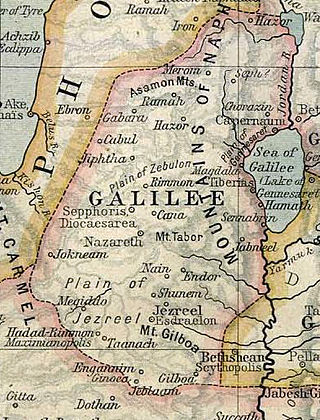
Ptolemais was an ancient port city on the Canaanite coast in the region of Palestine, in the location of the present-day city of Acre, Israel. It was also called Ptolemais in Canaan. It was an ancient bishopric that became a double Catholic titular see.
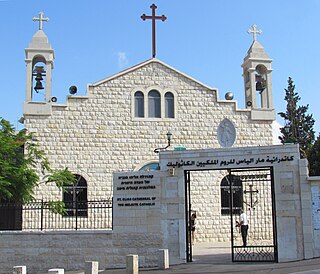
Melkite Greek Catholic Archeparchy of Akka is an Eastern Catholic diocese of Melkite Greek Catholic Church, directly subject to the Melkite Patriarch of Antioch. Its Cathedral episcopal see is St. Elijah Greek-Melkite Cathedral, in Haifa.
The Apostolic Vicariate of Beirut is a Latin Church ecclesiastical jurisdiction or apostolic vicariate of the Catholic Church in Lebanon, where Eastern Catholics are far more numerous. In 2010, there were 15,000 baptized. Its current bishop is Cesar Essayan.
Joseph Khoury was a former Archeparch of the Maronite Catholic Archeparchy of Tyre.
Catholic dioceses in the Holy Land and Cyprus is a multi-rite, international episcopate in Israel and Cyprus.
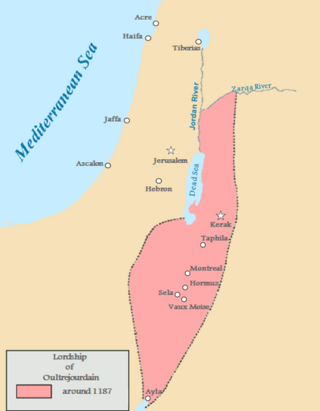
Guerricus was the metropolitan archbishop of Petra from 1167 or 1168 until his death at the Siege of Acre in 1190 or 1191. He was the only archbishop of Petra from the Crusader period and its only Latin Catholic bishop from the Middle Ages. Politically, his see belonged to the Kingdom of Jerusalem and roughly corresponded geographically to the secular Lordship of Oultrejordain.
The Roman Catholic Diocese of Sidon was a bishopric in the Kingdom of Jerusalem in the 12th and 13th centuries.
The Roman Catholic Archdiocese of Tyre was an archbishopric in the Kingdom of Jerusalem.
William I was the second Latin archbishop of Tyre from 1128 until 1134 or 1135. He was originally from England and served as prior of the Church of the Holy Sepulchre before his appointment as archbishop.
The Latin Diocese of Tripoli was established in 1104 in the aftermath of the First Crusade. It remained a residential bishopric until 1289, after which it became a titular bishopric, which it remains today in the Catholic Church.